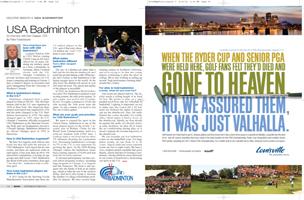
 |
| Dan Cloppas, CEO |
How long have you been with USA Badminton?
I joined USAB in 1999 as CEO. Before joining USAB, I was an Air Force officer for 26 years, finishing my military career as a base commander in Germany, where I worked closely with the U.S. Olympic Committee to provide facilities and resources for U.S. teams competing and training in Europe. I have a master’s degree in recreation and sport management from the University of Northern Colorado.
What is badminton’s history in the U.S.?
Badminton originated from a game played in China in 500 B.C. The first badminton club in the U.S. was organized in 1878 in New York. The American Badminton Association was organized in 1936 and the name changed to the U.S. Badminton Association in 1978. The name changed again in 1987, when the U.S. Olympic Committee officially recognized USA Badminton as the National Governing Body and our headquarters moved to Colorado Springs. Badminton debuted as an official Olympic sport in 1992 in Barcelona.
How is USA Badminton organized?
We have five regions, each with its own board, but they fall under the purview of USA Badminton. Each region has its own events, and there are numerous clubs in each region. Every year, there are 80 to 100 sanctioned tournaments, covering all age groups and skill levels. USA Badminton has about 4,000 active members, from ages 7 into their 90s—badminton truly is a lifetime sport.
How many badminton players are there in the U.S.?
A 2011 study by the Sporting Goods Manufacturers Association says there are 7.6 million players in the U.S., and of that total, about 2.8 million are “core” (13+ times a year) players.
What makes badminton different from other racquet sports?
The use of a shuttlecock rather than a ball, and the fact that the shuttlecock can’t touch the ground during a rally. What people don’t realize is that badminton is the fastest racquet sport in the world. At the elite level, the shuttlecock moves at over 200 miles an hour. The speed and agility of the players is incredible.
In 2006, the Badminton World Federation and USA Badminton adopted a new scoring system, the rally point system. To win a game, you need to win 21 points, by two. If a game continues to 29-all, the side scoring the 30th point wins the game. To win a match, you need to win two out of three games.
What are your goals and priorities for USA Badminton?
We want to expand the sport in the United States. Badminton is one of the most played sports in the world. I recently was in Wuhan, China for the World Team Championships, held in a sold-out stadium with 4,000 fans. I could go back to my hotel and see three TV channels showing the tournament live. Increasing badminton’s coverage on TV in the U.S. is very important for growing the sport. At the 2008 Beijing Olympic Games the badminton venue had a seating capacity of 8,000 and was sold-out for most sessions.
To increase participation, we have several school programs in place, including large programs in Chicago, Los Angeles and San Francisco. We need to put racquets into the hands of kids at an earlier age, which is what the rest of the world is doing. And we’re also trying to increase the number of college scholarships available for players. We have several large training centers in Southern California, and we’re trying to tie that into young players continuing to play the sport in college. We’re also looking at setting up several “high performance training hubs” around the country.
For sites to hold badminton events, what do you look for?
Our events are played indoors. The facility needs a ceiling height of at least 30 feet. We prefer to play on a suspended wood floor, like for volleyball or basketball. Lighting is important; we try to make sure the courts (44 x 20 feet each) are between the lights so players can see the shuttlecock. Also, the walls behind the courts shouldn’t be totally white, which makes it hard to focus on the shuttlecock. Ideally, air flow should be against the walls, not directly down; at some facilities, we shut off or lower the air conditioning during play, so it doesn’t impede the normal trajectory of the shuttlecock.
We can normally put four badminton courts on one basketball court. For large junior events, we use from 12 to 20 courts. Typical adult and senior national events use five to eight courts. We have a very complete packet available that gives details, criteria and tips for hosting a tournament. Having different cities interested in our events is beneficial to showcasing our sport in the U.S.


